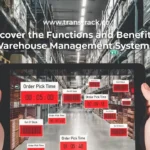The Importance of Truck Tire Pressure and How to Measure It!
Posted on June 24, 2024 by Nur Wachda Mihmidati

In the world of commercial transportation, maintaining optimal truck tire pressure is not a trivial matter. Proper tire pressure not only affects vehicle performance, but also has a significant impact on fuel efficiency, driver safety, and tire longevity. Check out the following article TransTRACK to know the importance of truck tire pressure!
Importance of Proper Tire Pressure
Maintaining proper tire pressure has several important benefits that affect various aspects of vehicle use, including safety, fuel efficiency, tire life, and vehicle performance. Here’s a more detailed explanation of each aspect:
Driving Safety
Maintaining proper tire pressure is essential for safe driving. Under- or over-pressurized tires can cause instability, especially when turning or braking suddenly. Optimal tire pressure ensures good contact between the tires and the road, reducing the risk of accidents.
Fuel Efficiency
Correct tire pressure contributes to a vehicle’s fuel efficiency. Underinflated tires increase rolling resistance, making the engine work harder and consume more fuel. With the right pressure, this resistance is reduced and the vehicle moves more efficiently, saving fuel.
Tire Life
Proper tire pressure extends the life of vehicle tires. Underinflated tires will wear quickly at the edges, while overinflated tires will wear in the center. Optimal pressure ensures an even distribution of wear, extending tire life.
Vehicle Performance
Optimal tire pressure improves the overall performance of the vehicle. Vehicles with properly inflated tires have better handling, increased stability, and optimal braking ability. This is especially important when driving in bad weather conditions or on uneven roads.
How to Measure Truck Tire Pressure
Measuring truck tire pressure can be done easily if you follow these steps:
Tools Needed
To measure truck tire pressure, you will need a few tools. The first is a tire pressure gauge, which can be an analog or digital gauge. You may also need additional valve covers and an air compressor to increase or decrease pressure as needed.
Measurement Steps
- Preparation: Make sure the truck is parked on a level ground and the engine is cold. This is important to get an accurate pressure reading.
- Removing the Valve Cap: Remove the valve cap on the tire to be measured, then press the tire pressure gauge against the valve until you hear a short hissing sound.
- Reading the Pressure Gauge: Read the measurement results on the gauge. Compare this result with the manufacturer’s recommended tire pressure which is usually indicated on a sticker on the driver’s door or in the vehicle manual.
- Adjusting Pressure: If the pressure is too low, add air using the compressor until it reaches the recommended pressure. If it is too high, release some air until the pressure is appropriate.
When to Measure?
Tire pressure should be measured regularly, at least once a month and before a long trip. Measurements should also be taken when there are extreme temperature changes, as temperature can affect tire pressure. Also, check tire pressure if you feel any changes in the truck’s handling or performance while driving.
Truck Tire Pressure Standard
Truck tire pressure is determined by vehicle weight, tire type, and road conditions. The general recommendation for light trucks is 50-80 psi, while heavy trucks require 80-120 psi. Pressure should be checked regularly, at least once a month and before long trips, with adjustments made when tires are cold to ensure safety, efficiency, and tire longevity.
What Happens When Tire Pressure is Too Low?
If tire pressure is too low, it can cause several problems. Safety risks increase as underinflated tires can overheat and blow out, and vehicle handling and stability decrease. Fuel efficiency is also affected as underinflated tires increase rolling resistance, so the engine has to work harder and fuel consumption goes up. In addition, tire life becomes shorter due to uneven wear, usually wearing faster at the edges. Overall vehicle performance is also reduced as steering, braking and acceleration responses become less optimal.
Problems Arising from Improper Tyre Pressure
Improper tire pressure in vehicle tires can cause various problems that affect vehicle safety and performance.
Tire Blowout or Explosion
Too low pressure causes tires to overheat due to increased friction with the road, which can lead to a tire blowout. Conversely, too high a pressure makes tires more susceptible to impact damage and can lead to tire blowouts when exposed to excessive pressure.
Poor Handling
Improper tire pressure affects the controllability of the vehicle. Underinflated tires make the vehicle more difficult to control, especially when turning or braking suddenly. Overinflated tires also reduce the contact area with the road, reducing traction and stability.
Uneven Tire Wear
Tires with improper pressure will experience uneven wear. Low tire pressure causes faster wear at the edges, while too high pressure causes faster wear in the center of the tire. Uneven wear reduces tire life and requires replacement sooner.
Wheel and Suspension Damage
Improper tire pressure can cause excessive stress on wheel and suspension components. Underinflated tires make the suspension work harder to absorb shock, which can cause damage to the suspension and wheels. Too high tire pressure also puts more stress on the suspension and can cause damage in the long run.
Ensuring that tire pressure is always correct is an important step to maintaining the safety, efficiency, and longevity of vehicle components.
To maintain optimal performance and safety on the road, it is important to always check and confirm your truck’s tire pressure. Utilize TransTRACK’s Vehicle Maintenance System to efficiently manage your vehicle maintenance. With TransTRACK, you can monitor tire pressure in real-time and get early alerts on required maintenance, so your vehicle stays in the best condition on every trip.
Recent Post
Topic :
 Bahasa Indonesia
Bahasa Indonesia









